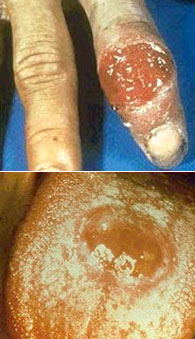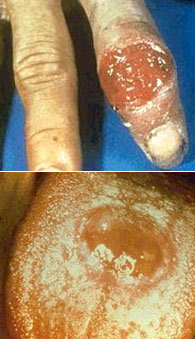Intro
No, it's not some disease relegated to history books (fossilized remains of human prehistoric man show signs of bone destruction often seen from syphilis -- and even George Washington was rumored to have had it!) Syphilis is very much a health threat in our oh so modern times. The Centers for Disease Control and Prevention (CDC) estimates that more than 40,000 new infections occurred last year, with at least half of them in men who have sex with men. Although physicians have been able to successfully treat syphilis since the advent of penicillin in 1943, many cases still go undiagnosed. If ignored, the disease can be fatal.

Syphilis is a sexually transmitted infection caused by the corkscrew shaped bacteria (spirochete) Treponema pallidum. The bacteria lands on your body during sex with an infected partner. The most common sites of infection are the penis, anus or vagina. Within 90 days of infection (two to four weeks average) a red, painless ulcer called a chancre appears. The chancre, though usually singular, can be multiple, and will heal even without treatment within three to eight weeks. This first stage of infection is called primary syphilis. The chancre weeps a clear fluid that is chock full of syphilis-causing bacteria, and it is during this stage that you are highly contagious. After the chancre heals, the bacteria spread throughout your body. This is called secondary syphilis.
Infected individuals usually complain of fever, joint pains, fatigue, liver problems, enlarged lymph nodes, eye problems and a copper colored skin rash that usually appears on your palms and soles. You are still contagious at this stage. If untreated, 40 percent of infected individuals progress to Tertiary Syphilis within 10 to 20 years. Although no longer contagious, the disease can prove lethal, as it attacks your brain (destroying your vision and hearing) and may ultimately lead to insanity. The disease also attacks your heart valves and major arteries (most commonly the aorta). And more bad news: even if you've had syphilis once before and were cured, you can still catch it again.
Diagnosis
In 1906, Dr. August von Wassermann developed the first test to diagnose syphilis (The Wassermann). Some physicians use a darkfield microscope to examine a sample of fluid from your chancre. You have syphilis if they see the spirochete bacteria. Today the most common test for syphilis is a blood test that looks for antibodies to the spirochete. It is called a VDRL (Venereal Disease Research Laboratory) or FTA-ABS (florescent treponemal antibody absorption) test. Another blood test often used to confirm the presence of active infection is called an RPR (rapid plasma reagin).
Symptoms
Primary syphilis: a painless red ulcer called a chancre. Secondary syphilis: symptoms of viral illness including fever, joint pains, swollen lymph nodes. A copper-colored skin rash, particularly on your palms and soles is classic. Like the chancre, the rash also goes away even without treatment within two to six weeks. Tertiary syphilis: central nervous system damage including blindness, loss of hearing and insanity. Heart disease (destruction of heart valves) and vascular disease (aortic anneurysm) are also common.

Primary syphilis or syphilis of less than one year duration: Benzathine penicillin G - 2.4 million units by injection or oral doxycycline 100mg twice a day or tetracycline 500mg four times a day for 2 weeks. Syphilis infections of greater than one year duration or of unknown duration: Benzathine penicillin G - 2.4 million units by injection weekly for 3 weeks or either of the above oral medications for four weeks duration. A penicillin derivative is still the drug of choice, but doxycycline or tetracycline works well for penicillin-allergic individuals. No matter what type of syphilis you have, a critical treatment step is notification of all of your sexual partners. They must also be treated.
Myths dispelled
Here are some facts to clear up some common misconceptions. Syphilis was probably not brought to the New World by Columbus's crew. Even though your chancre goes away without treatment, you are not cured. You cannot catch syphilis from toilet seats or in gyms or swimming pools (unless you're doing more than laps).
Prevention
Although a condom will generally prevent syphilis infection, it must be worn from the start of close physical contact.
If your partner has a chancre at the base of his shaft, scrotum or pubic hair, a condom will probably not protect you. The spirochete is extremely sensitive to drying and is easily killed with soap and water. Washing up after sex will go a long way in preventing infection. Heterosexual couples in the United States are often routinely tested for syphilis as part of a marriage license procedure; gay couples, however, are presently denied the right to marry and thus often do not undergo a syphilis test. As part of prevention, we must routinely ask for syphilis screening.
Of particular concern to
Men who have sex with men and people in lower socioeconomic groups have a higher rate of syphilis infection. The United States has the highest rate of syphilis of any industrialized nation. Some nations, including Canada, have all but eradicated syphilis.
Of particular concern to Men
The chancre most often appears on or close to the glans (head) of your penis. It can also be further down the shaft or on the scrotum. If you have anal syphilis, the chancre might be inside your anal opening, making it hard to spot. In these instances, the chancre might be confused with an anal fissure. In fact, some men have even mistakenly had surgery when antibiotics would have cured the problem.
Of particular concern to Women
Lesbians often don't think about their risk for syphilis, assuming it is more of a man's disease. Although heterosexual sex and male homosexual sex are the most common ways syphilis is spread, many lesbians have or have had sex with men. A lesbian can spread syphilis she caught from a man to her unsuspecting partner either orally or through shared toys. In the vagina, a chancre is almost impossible to spot. A pregnant woman can also pass syphilis on to her unborn child.
Of particular concern to Ethnic
There are higher rates of syphilis infection among lower socioeconomic groups. African-Americans account for 80 percent of cases of syphilis in the United States, while Hispanics account for six percent.
Of particular concern to Immune Compromised
Syphilis may be harder to diagnose in people with HIV or other immune compromised individuals who do not make antibodies to the infection. In other words, they may have syphilis despite a negative blood test. Your risk for catching or passing HIV when you have syphilis is two to five times greater.
Incubation period
A chancre develops within 90 days, and within two to four weeks is average. It heals within three to eight weeks, and if untreated, secondary syphilis begins. If syphilis is still not treated, tertiary syphilis may begin 10 to 20 years later.
Sex
A condom may not protect you, especially if your partner has a chancre on the base of his shaft or on his scrotum. Chancres of the anus or vagina can be extremely difficult to spot.
Prevalence
There were more than 40,000 cases of syphilis in the United States last year, and more than half represented men who have sex with men. There's a higher prevalence among lower socioeconomic groups. The vast majority of cases in the U.S. occurred in Southern states (anyone want to move North?).











 打印版本
打印版本











读者回应
抢先发表第一个回应吧!
请先登入再使用此功能。